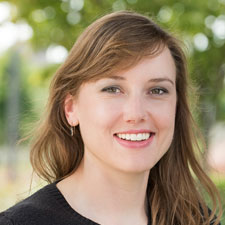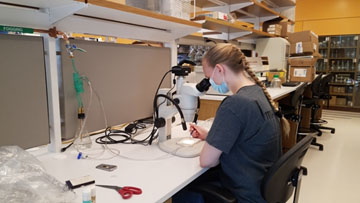What determines our species - our membership in team Homo sapiens? Or our assigned gender at birth? In part, we are classified by our chromosomes – the supramolecular assemblies that organize our genomes. How chromosomes are passed down through generations, and the consequences of defects in chromosome dynamics on health and evolution are amongst the research themes of our new MCB faculty member Professor Stacey Hanlon.
 Professor Hanlon’s introduction to research was as an undergraduate at Texas A&M University, where she was using classic genetic techniques to map a mutation that produced abnormal courtship behavior in the fruit fly, Drosophila melanogaster. Switching to a simpler model system for her doctoral studies at the University of California, San Francisco, Professor Hanlon focused on DNA replication control in budding yeast. Loss of replication control can lead to chromosome instability, and her work in Prof. Joachim Li’s lab focused on how re-replication through the centromeric region affected chromosome segregation. Using modern molecular genetic techniques, Professor Hanlon found that chromosomes with a re-replicated centromere often missegregated during cell division, leading to an abnormal number of chromosomes in the daughter cells. These studies spurred on continued interest in chromosome dynamics. For her post-doctoral work, Professor Hanlon looked for a project that would allow her to continue her interest in chromosome biology while letting her carve out her scientific niche. She joined Prof. Scott Hawley’s lab at the Stowers Institute in Kansas City, MO, just as the presence of B chromosomes in Drosophila melanogaster was becoming known.
Professor Hanlon’s introduction to research was as an undergraduate at Texas A&M University, where she was using classic genetic techniques to map a mutation that produced abnormal courtship behavior in the fruit fly, Drosophila melanogaster. Switching to a simpler model system for her doctoral studies at the University of California, San Francisco, Professor Hanlon focused on DNA replication control in budding yeast. Loss of replication control can lead to chromosome instability, and her work in Prof. Joachim Li’s lab focused on how re-replication through the centromeric region affected chromosome segregation. Using modern molecular genetic techniques, Professor Hanlon found that chromosomes with a re-replicated centromere often missegregated during cell division, leading to an abnormal number of chromosomes in the daughter cells. These studies spurred on continued interest in chromosome dynamics. For her post-doctoral work, Professor Hanlon looked for a project that would allow her to continue her interest in chromosome biology while letting her carve out her scientific niche. She joined Prof. Scott Hawley’s lab at the Stowers Institute in Kansas City, MO, just as the presence of B chromosomes in Drosophila melanogaster was becoming known.
B chromosomes have nothing to do with bees but are designated as ‘B’ chromosomes because, unlike the essential ‘A’ chromosomes, they are not critical for growth and reproduction and can be lost. B chromosomes have been known for over 100 years in organisms as varied as plants, fish, mice, grasshoppers, and yes, even bees!** Operationally, B chromosomes are also relevant to humans, since about 0.06% of the population carries small abnormal supernumerary chromosomes that can be associated with intellectual disability or infertility but can also have no recognizable effects.

The D. melanogaster B chromosome that Prof. Hanlon studies appears to have arisen from Chromosome 4 through an unknown mechanism. The B chromosome does not appear to carry any protein coding genes, which begs the existential question: what causes the B chromosome to be, or not to be? Prof. Hanlon’s working hypothesis is that the B chromosomes have been maintained in their original stock through an intriguing phenomenon called meiotic drive. The textbook view of meiosis – the specialized cell division that produces eggs in females and sperm in males – is that each pair of chromosomes are randomly segregated, meaning both copies have an equal chance of ending up in the egg or the sperm. This process is in accordance with Mendel’s Law of Segregation, which predicts that ‘everything is fair’ (based on our interview I gathered that ‘everything is fair’ may be Prof. Hanlon’s favorite expression). When meiotic drive is in effect, however, inheritance of elements such as the B chromosome is anything but random. During her postdoctoral work, Professor Hanlon discovered that the B chromosomes are genetic renegades that cheat during meiosis and are inherited at a higher frequency than expected! Since these B chromosomes do not carry protein-coding genes, what’s the harm of having a few around? It turns out these small B chromosomes pack a big punch during meiosis and can disrupt the segregation of the A chromosomes, which poses a significant genomic conflict: the B chromosomes have a mechanism to act selfishly and get passed to progeny at a high frequency, but natural selection is working against the B chromosomes because their presence wreaks havoc during meiosis and lead to a reduction in fertility. Whether ‘tis nobler of the fly to suffer, the slings and arrows of outrageous fortune, or to take arms against a B of troubles?
Professor Hanlon’s lab is profoundly interested in the genetic factors that resolve the genomic conflict between what is best for the host and what is best for the B chromosomes. What keeps the balance between Mendelian inheritance and natural selection versus the meiotic drive of a selfish genetic element? Are protein gradients involved or does the structure of the B chromosome have to do with its selfish behavior during meiosis? How do cells count chromosomes, to ensure the proper number? How do small chromosomes affect the behavior of the others during meiosis? Answers to these questions will shed fundamental light on our understanding of aneuploidy, the occurrence of one or more extra or missing chromosomes. Aneuploidy occurs due to errors in chromosome segregation, and when this occurs during meiosis, it can result in infertility and disorders such as Down syndrome. From an evolutionary perspective, we can expect new insights into how and where new chromosomes arise, as well as what can influence their frequency of formation such as maternal age or exposure to a small molecule. Equally important for the progress of the research, is the recruitment of talented students. In the Hanlon lab, students can expect to receive training in modern molecular biology techniques, classic genetics, and cytogenetics, amongst other areas. Everything being fair, we expect the Hanlon lab to provide many contributions to our understanding of chromosome segregation, meiotic drive, and genomic conflict in the years to come.
** (Comp Cytogenet. 2018; 12(4): 471–482.
Written by Andrei Alexandrescu